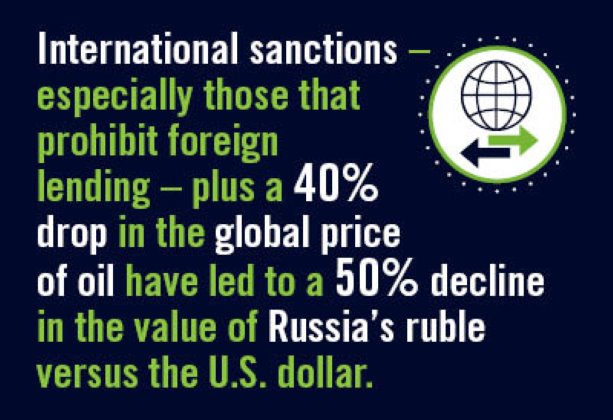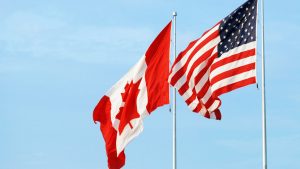Minus forty and minus fifty equals plus six-and-a-half. There is a logical explanation for this equation.
International sanctions – especially those that prohibit foreign lending – plus a 40% drop in the global price of oil have led to a 50% decline in the value of Russia’s ruble versus the U.S. dollar.
In an effort to halt the exchange rate carnage, Moscow’s central bank has raised its key interest rate from 10.5% to a staggering 17.0%, the six-and-a-half percentage point increase referenced in the headline.
It still hasn’t been enough to stop the ruble’s plummet. The next likely step is currency controls – i.e., restrictions on selling rubles for dollars, euros, yen, etc.
The Russian economy is in deep trouble. Thanks to past energy sales to Europe, the country has immense foreign exchange reserves that can be employed as a safety net, for a while. Even this has a limit, though, and there’s a clock that’s ticking.
Premier Putin has two choices. He can relent and scale back his military intervention in Ukraine, while also reining in risky “Top Gun” flights in the skies over Europe. A Swedish passenger airliner recently barely avoided collision with a Russian jet that was on a clandestine reconnaissance mission.
Or he can continue to blame the West for all his nation’s problems and hope that the balance of public opinion at home will continue to be on his side.
The longer the economic situation is allowed to deteriorate, the less likely it is that option two will continue to produce positive results for the current regime headed by Mr. Putin and a few of his Oligarchy cronies.
A falling ruble is lifting import prices in Russia and sending inflation soaring. The cost of travel abroad is becoming prohibitive.
For the rest of the world, there is the danger that Russia may renege on its foreign debt. It’s happened before, as recently as in 1998.
Heading into 2015, expect a flurry of media speculation about the possible consequences of a Russian debt default for what many consider to be a still-fragile world banking system.
Continuing with a financial theme, the various thrusts of central bank interest rate policies around the world are about as diverse now as they have ever been.
Beijing recently lowered yields in an attempt to squeeze more growth out of China’s economy.
Europe and Japan are experimenting with zero or negative interest rates. Falling oil prices are exacerbating worries about deflation in those jurisdictions. When prices are retreating, people and enterprises delay purchases in hopes of further reductions.
The U.S. Federal Reserve is operating in an alternate universe. Bearing witness to a robust labor market revival, it is bolstering the rhetoric concerning a rate rise.
The language in the press release accompanying the latest meeting of the Federal Open Market Committee (FOMC) has finally been revised.
A record-low federal funds rate is no longer being assured for a “considerable” period of time. Rather, “patient” attention will be paid to when initial tightening may be required.
Debate about the timing, among FOMC members, will become more heated by March of next year, with “odds-makers” still favoring first-step action by summer.
The Chairman of the Fed, Janet Yellen, has asserted that there may be one significant departure from previous periods of interest rate “normalization”. By the way, if you’re looking for a 2015 buzz work, “normalization” in the aftermath of the Great Recession fits the bill across a wide spectrum of topic areas.
In this latest recovery/expansion, there won’t necessarily be automatic 25 basis-point (where 100 basis points = 1.00%) upward adjustments in the key policing-setting interest rate (i.e., the federal funds rate) with each successive FOMC meeting.
There’s no denying that the low interest rates in the U.S. (0.00% to 0.25% for the federal funds rate) and Canada (1.00% for the “overnight rate”) have been a spur to at least one major area of consumer expenditures, motor vehicle sales.
Graphs 1 and 2 show unit auto sales in the U.S. and Canada respectively. The U.S. has achieved a nice rebound. Full-year 2014 sales south of the border will be nearly 16.5 million units, close to what they were on a consistent basis prior to the 2008-09 recession.
We’ll stop here for now. Part 2 of this article will examine U.S. and Canadian auto sales in more detail, before also exploring capacity utilization rates in both countries and asking how close they are to the benchmark 85.0%.











Recent Comments
comments for this post are closed